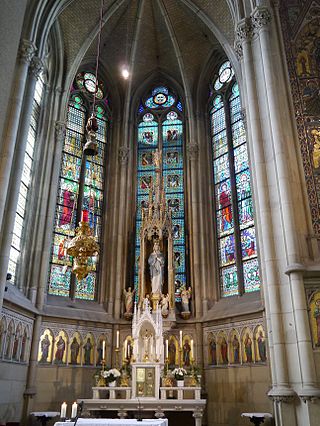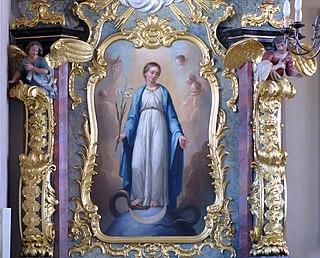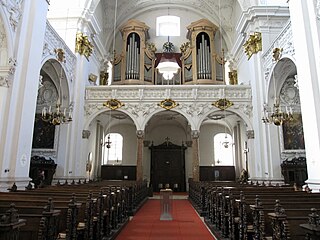
In Western classical music, a motet is mainly a vocal musical composition, of highly diverse form and style, from high medieval music to the present. The motet was one of the pre-eminent polyphonic forms of Renaissance music. According to Margaret Bent, "a piece of music in several parts with words" is as precise a definition of the motet as will serve from the 13th to the late 16th century and beyond. The late 13th-century theorist Johannes de Grocheo believed that the motet was "not to be celebrated in the presence of common people, because they do not notice its subtlety, nor are they delighted in hearing it, but in the presence of the educated and of those who are seeking out subtleties in the arts".

The Mass No. 2 in E minor, WAB 27 is a setting of the mass ordinary for eight-part mixed choir and fifteen wind instruments, that Anton Bruckner composed in 1866.

Ecce sacerdos magnus, WAB 13, is an 1885 sacred motet by the Austrian composer Anton Bruckner. It is a musical setting of the antiphon of the same title.

Virga Jesse, WAB 52, is a motet by the Austrian composer Anton Bruckner. It sets the gradual Virga Jesse floruit for unaccompanied mixed choir.

Vexilla regis, WAB 51, is the final motet written by the Austrian composer Anton Bruckner.

Tota pulchra es, WAB 46, is a sacred motet by the Austrian composer Anton Bruckner.

Locus iste, WAB 23, is a sacred motet composed by Anton Bruckner in 1869. The text is the Latin gradual Locus iste for the annual celebration of a church's dedication. The incipit, Locus iste a Deo factus est, translates to "This place was made by God". Bruckner set it for four unaccompanied voices, intended for the dedication of the Votivkapelle at the New Cathedral in Linz, Austria, where Bruckner had been a cathedral organist. It was the first motet that Bruckner composed in Vienna. It was published in 1886, together with three other gradual motets.

Kirchweih is literally the dedication of a church in German. More generally it also names the celebration of the anniversary of a dedication both at church and in local customs. The festivity is often on the day celebrating a church's patron saint or the day of laying the foundation stone, now often celebrated the following weekend. Customs vary locally in German-speaking countries, also local names such as Kirtag, Kärwa, Kirmes and Kilbi. In Bavaria, all Kirchweih celebrations have been fixed by royal order from the mid-19th century to the third Sunday in October.

Ave Maria, WAB 6, is a sacred motet by Anton Bruckner, a setting of the Latin prayer Ave Maria. He composed it in Linz in 1861 and scored the short work in F major for seven unaccompanied voices. The piece, sometimes named an Offertorium, was published in Vienna in 1867. Before, Bruckner composed the same prayer in 1856 for soprano, alto, a four-part mixed choir, organ and cello, WAB 5. Later, he set the text in 1882 for a solo voice (alto) and keyboard, WAB 7.

Christus factus est, WAB 11, is a sacred motet by Anton Bruckner, his third setting of the Latin gradual Christus factus est, composed in 1884. Before, Bruckner composed in 1844 a first piece on the same text as gradual of the Messe für den Gründonnerstag, and in 1873 a motet for eight-part mixed choir, three trombones, and string instruments ad libitum. The motet is an expressive setting of the gradual, influenced by Wagner's music.
Christus factus est is taken from Saint Paul's Epistle to the Philippians. It is a gradual in the Catholic liturgy of the Mass. In pre-Vatican II Roman Rite practice, it was sung as the gradual at Mass on Maundy Thursday, however since the promulgation of the post-Vatican II Mass by Pope Paul VI in 1969 it has been employed instead as the gradual on Palm Sunday. Up until 1970 it was also sung daily at the conclusion of Tenebrae on the last days of Holy Week. It appeared first at Tenebrae of Maundy Thursday, but was not recited in full, ending with "...usque ad mortem". The following day at Tenebrae of Good Friday it was sung from the beginning until "...mortem autem crucis" and at Tenebrae of Holy Saturday it was sung in full. Up until the reform of the Holy Week liturgy promulgated by Pius XII in 1955 these Tenebrae services were sung in the late afternoon and evening of the previous day, and were well attended by the laity. Thus Tenebrae of Maundy Thursday was sung during the evening of Spy Wednesday; Tenebrae of Good Friday in the evening Maundy Thursday etc. For this reason Christus factus est was set by many composers of church music. From 1956 through 1969, and in the liturgical books of 1962 which are currently in use as the extraordinary form of the Roman Rite, these services have been place back in early mornings of the last three days of Holy Week, with the effect that complex musical settings of this text are rarely heard in their liturgical context.

Os justi, WAB 30, is a sacred motet composed by Anton Bruckner in 1879. Os Justi is a Gregorian chant used as gradual of the Commune Doctorum, and as introit I and gradual II of the Commune Confessoris non Pontificis.

Libera me, WAB 21, is the first of two settings of the absoute Libera me, composed by Anton Bruckner in c. 1843.

Libera me, WAB 22, is the second of two settings of the absoute Libera me, composed by Anton Bruckner in 1854.

Salvum fac populum tuum, WAB 40, is a motet composed by Anton Bruckner in 1884.

Pange lingua, WAB 33, is a sacred motet composed by Anton Bruckner in 1868. It is a setting of the Latin hymn Pange lingua for the celebration of Corpus Christi.

Du bist wie eine Blume, WAB 64, is a song, which Anton Bruckner composed in 1861.

Vaterlandslied, WAB 92, is a patriotic song composed by Anton Bruckner during his stay in Linz.

Locus iste, is a sacred motet composed by Paul Mealor in 2011. The text is the Latin gradual Locus iste for the annual celebration of a church's dedication. Mealor set it for four unaccompanied voices, at times divided, for the 500th anniversary of the King's College Chapel in Aberdeen in 2009.

















